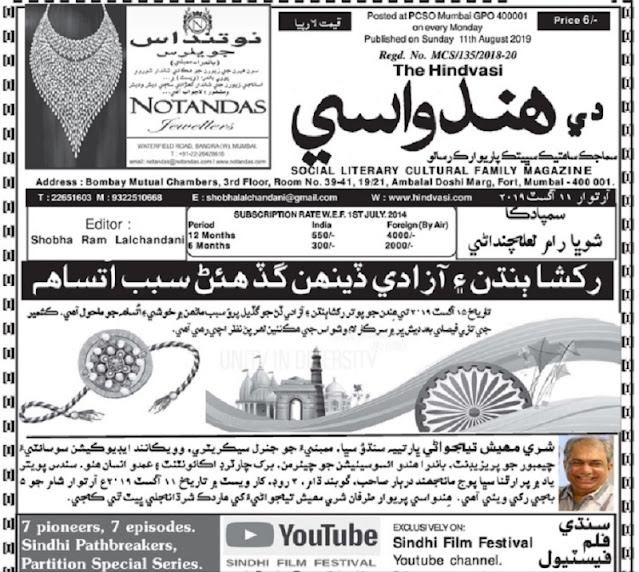A Book on Shah Hyder Sannai
During the 1960s, when Sain GM Syed was house arrested, he got time to rethink on different perspectives of Sindh, including its history, geography, culture, language and heroes. In this regard this great thinker and philosopher of our time Sain GM Syed laid foundation of "Bazm-e-Sufiya-e-Sindh" and wrote books like "Sindh ja Surma", "Sindhi Culture" and "Sindh h ji Saniyah", these books laid strong foundations of Sindh's unique identity as a peace-loving state, with secular and mystic norms.
I think this book on Shah Hyder Sannai, which is result of Dr. Zia Shah's (grandson of Sain GM Syed) scholarly approach towards history, published by SHEES on the occasion of 500th death anniversary of Shah Hyder Sannai, is continuation of Syed's unique vision for Sindh. This book spread over 280 pages can be divided into three major portions:
(a) Articles, (28 articles contributed by 12 scholars and researchers),
(b) photographs (more than 50 colored photos) and,
(c) poetry.
While the articles can also be divided into three categories, (1) on life of Shah Hyder Sannai, (2), The Syed family of Sann, and (3) history of Sann. There are two articles by Sain GM Syed, three articles by Dr. Zia Shah, two articles by Mr. Taj Joyo, five articles by Rasool Bux Bughio, Seven articles by Khuda Bux Joyo, while one article each by Sain Imdad Mohammad Shah, Mr. Abdul Wahid Arisar, Ayub Umrani, Azad Qazi, Gul Sanai, and M. Hanif Lashari. These articles not only provide the readers complete life story and heroic efforts of Hyder Shah Sannai, but also sheds light on history of Sann and Sindh in particular, while on history of Asia in general.
I would like to mention work of two scholars particularly, Sain GM Syed and Dr. Zia Shah. Beginning with Dr. Zia Shah's article "Qadeem Sindh aeen Shah Hyder jo Dorr". In my opinion, this article is the perfect example of a research article according to modern scientific research techniques adopted worldwide. Dr. Zia Shah gives us a complete overview of Sindh's history, starting from Aryan invasion over Dravidians (the aboriginal Sindhis), to the Aurguns and Mughals who invaded and looted Sindh. He also mentions role of a Sindhi ruler during the time of Mahabharata, he gives account of dynasties ruling Sindh and other parts of world year wise. Then he compares the development of Europe during 16th and 17th century A.D, on the other hand downfall of Muslim imperialism.
This article is followed by Sain GM Syed's interesting article "Sannai Syedan jee Mashoor aeen Mookhya Hastiyan jo Ahwal". According to me this article is the soul of this whole book, and many researchers have built their thesis on basis of this detailed article, it is spread over 39 pages with a genealogical table of Shah Hyder Sannai, who is from family of Syeds of Matyari. It puts light on very important events such as Shah Hyder's meeting with his spiritual leader Mukhdoom Bilawal (A saint of Saamma dynasty in Sindh, who was martyred by Shah Beg Aurgun) and the heroic efforts of Shah Hyder Sannai to stop Syed Miran Shah Junpuri (the lair), who claimed to be Imam Mehdi,, many scholars like Qazi Qazan, a priest at court. When Junpuri, the lair reached near Sann, he sent his message to notables of the city to receive him with honor and dignity. But Shah Hyder Saanai sent his men, who damaged the enemy boats, in result Junpuri, the lair fled to Afghanistan by land, in this way a fake claim faced resistance in Sindh, on hands of Mukhdoom Bilawal and his disciples.
Mr. Ayub Umrani, in his article mentions three important struggles by Shah Hyder Saanai:
(a) Struggle against Chang tribe to demolish their unjust hold,
(b) Struggle against Junpuri, the lair, and
(c) Struggle against Aurguns for independence of Sindh.
The articles of Mr. Khuda Bux Joyo are also praiseworthy, he gives us a unique historic record of Sann and the Syed family.
In my opinion this scholarly and well researched work should have a reference table and appendices at the end, I hope in the revised edition these things will be added. What I believe is, this book will be used as a reference book by the future researchers willing do research on this topic.
x




Comments
Post a Comment